Plasmonic Metamaterial Ag Nanostructures on a Mirror for Colorimetric Sensing
Abstract
1. Introduction
2. Materials and Methods
2.1. Simulations
2.2. Sample Preparations
2.3. Observations and Measurements
3. Results and Discussion
3.1. Design and Calculation for Vivid Color Tuning
3.2. Experimental Verification of Color Tuning using Random Structures
3.3. Comparison of Random Structures and Periodic Aligned Structures
3.4. Colorimetric Sensing and its Potential for Biosensor Applications
4. Conclusions
Supplementary Materials
Author Contributions
Funding
Data Availability Statement
Acknowledgments
Conflicts of Interest
References
- Lee, T.; Jang, J.; Jeong, H.; Rho, J. Plasmonic-and dielectric-based structural coloring: From fundamentals to practical applications. Nano Converg. 2018, 5, 1–21. [Google Scholar] [CrossRef]
- Kumar, K.; Duan, H.; Hegde, R.; Koh, S.C.W.; Wei, J.; Yang, J.K. Printing colour at the optical diffraction limit. Nat. Nanotechnol. 2012, 7, 557–561. [Google Scholar] [CrossRef]
- Goh, X.M.; Zheng, Y.; Tan, S.J.; Zhang, L.; Kumar, K.; Qiu, C.-W.; Yang, J.K.W. Three-dimensional plasmonic stereoscopic prints in full colour. Nat. Commun. 2014, 5, 5361. [Google Scholar] [CrossRef]
- Zhu, X.; Vannahme, C.; Højlund-Nielsen, E.; Mortensen, N.A.; Kristensen, A. Plasmonic colour laser printing. Nat. Nanotechnol. 2016, 11, 325–329. [Google Scholar] [CrossRef]
- Tan, S.J.; Zhang, L.; Zhu, D.; Goh, X.M.; Wang, Y.M.; Kumar, K.; Qiu, C.-W.; Yang, J.K.W. Plasmonic Color Palettes for Photorealistic Printing with Aluminum Nanostructures. Nano Lett. 2014, 14, 4023–4029. [Google Scholar] [CrossRef]
- Miyata, M.; Hatada, H.; Takahara, J. Full-Color Subwavelength Printing with Gap-Plasmonic Optical Antennas. Nano Lett. 2016, 16, 3166–3172. [Google Scholar] [CrossRef]
- Wang, H.; Wang, X.; Yan, C.; Zhao, H.; Zhang, J.; Santschi, C.; Martin, O.J.F. Full Color Generation Using Silver Tandem Nanodisks. ACS Nano 2017, 11, 4419–4427. [Google Scholar] [CrossRef]
- Clausen, J.S.; Højlund-Nielsen, E.; Christiansen, A.B.; Yazdi, S.; Grajower, M.; Taha, H.; Levy, U.; Kristensen, A.; Mortensen, N.A. Plasmonic Metasurfaces for Coloration of Plastic Consumer Products. Nano Lett. 2014, 14, 4499–4504. [Google Scholar] [CrossRef]
- Yue, W.; Gao, S.; Lee, S.-S.; Kim, E.-S.; Choi, D.-Y. Subtractive Color Filters Based on a Silicon-Aluminum Hybrid-Nanodisk Metasurface Enabling Enhanced Color Purity. Sci. Rep. 2016, 6, 29756. [Google Scholar] [CrossRef]
- Hu, X.L.; Sun, L.B.; Zeng, B.; Wang, L.S.; Yu, Z.G.; Bai, S.A.; Yang, S.M.; Zhao, L.X.; Li, Q.; Qiu, M.; et al. Polarization-independent plasmonic subtractive color filtering in ultrathin Ag nanodisks with high transmission. Appl. Opt. 2016, 55, 148–152. [Google Scholar] [CrossRef]
- Inoue, D.; Miura, A.; Nomura, T.; Fujikawa, H.; Sato, K.; Ikeda, N.; Tsuya, D.; Sugimoto, Y.; Koide, Y. Polarization independent visible color filter comprising an aluminum film with surface-plasmon en-hanced transmission through a subwavelength array of holes. Appl. Phys. Lett. 2011, 98, 093113. [Google Scholar] [CrossRef]
- Yokogawa, S.; Burgos, S.P.; Atwater, H.A. Plasmonic Color Filters for CMOS Image Sensor Applications. Nano Lett. 2012, 12, 4349–4354. [Google Scholar] [CrossRef]
- Li, Z.; Clark, A.W.; Cooper, J.M. Dual Color Plasmonic Pixels Create a Polarization Controlled Nano Color Palette. ACS Nano 2016, 10, 492–498. [Google Scholar] [CrossRef]
- Goh, X.M.; Ng, R.J.H.; Wang, S.; Tan, S.J.; Yang, J.K. Comparative Study of Plasmonic Colors from All-Metal Structures of Posts and Pits. ACS Photonics 2016, 3, 1000–1009. [Google Scholar] [CrossRef]
- Shrestha, V.R.; Lee, S.-S.; Kim, E.-S.; Choi, D.-Y. Aluminum Plasmonics Based Highly Transmissive Polarization-Independent Subtractive Color Filters Exploiting a Nanopatch Array. Nano Lett. 2014, 14, 6672–6678. [Google Scholar] [CrossRef]
- Olson, J.; Manjavacas, A.; Liu, L.; Chang, W.-S.; Foerster, B.; King, N.S.; Knight, M.W.; Nordlander, P.; Halas, N.J.; Link, S. Vivid, full-color aluminum plasmonic pixels. Proc. Natl. Acad. Sci. USA 2014, 111, 14348–14353. [Google Scholar] [CrossRef]
- Si, G.; Zhao, Y.; Lv, J.; Lu, M.; Wang, F.; Liu, H.; Xiang, N.; Huang, T.J.; Danner, A.J.; Teng, J.; et al. Reflective plasmonic color filters based on lithographically patterned silver nanorod arrays. Nanoscale 2013, 5, 6243–6248. [Google Scholar] [CrossRef]
- James, T.D.; Mulvaney, P.; Roberts, A. The Plasmonic Pixel: Large Area, Wide Gamut Color Reproduction Using Aluminum Nanostructures. Nano Lett. 2016, 16, 3817–3823. [Google Scholar] [CrossRef]
- Walls, K.; Chen, Q.; Collins, S.; Cumming, D.R.S.; Drysdale, T.D. Automated Design, Fabrication, and Characterization of Color Matching Plasmonic Filters. IEEE Photon. Technol. Lett. 2012, 24, 602–604. [Google Scholar] [CrossRef]
- Fannin, A.L.; Wenner, B.R.; Allen, J.W.; Allen, M.S.; Magnusson, R. Properties of mixed metal–dielectric nanogratings for application in resonant absorption, sensing, and display. Opt. Eng. 2017, 56, 121905. [Google Scholar] [CrossRef]
- Wang, J.; Fan, Q.; Zhang, S.; Zhang, Z.; Zhang, H.; Liang, Y.; Cao, X.; Xu, T. Ultra-thin plasmonic color filters incorporating free-standing resonant membrane waveguides with high transmission efficiency. Appl. Phys. Lett. 2017, 110, 031110. [Google Scholar] [CrossRef]
- Duempelmann, L.; Casari, D.; Luu-Dinh, A.; Gallinet, B.; Novotny, L. Color Rendering Plasmonic Aluminum Substrates with Angular Symmetry Breaking. ACS Nano 2015, 9, 12383–12391. [Google Scholar] [CrossRef]
- Zeng, B.; Gao, Y.; Bartoli, F.J. Ultrathin Nanostructured Metals for Highly Transmissive Plasmonic Subtractive Color Filters. Sci. Rep. 2013, 3, 2840. [Google Scholar] [CrossRef]
- Wu YK, R.; Hollowell, A.E.; Zhang, C.; Guo, L.J. Angle-Insensitive Structural Colours based on Me-tallic Nanocavities and Coloured Pixels beyond the Diffraction Limit. Sci. Rep. 2013, 3, 1194. [Google Scholar]
- Uddin, M.J.; Magnusson, R. Efficient Guided-Mode-Resonant Tunable Color Filters. IEEE Photonics Technol. Lett. 2012, 24, 1552–1554. [Google Scholar] [CrossRef]
- Kaplan, A.F.; Xu, T.; Guo, L.J. High efficiency resonance-based spectrum filters with tunable transmission bandwidth fabricated using nanoimprint lithography. Appl. Phys. Lett. 2011, 99, 143111. [Google Scholar] [CrossRef]
- Skinner, J.L.; Talin, A.A.; Horsley, D.A. A MEMS light modulator based on diffractive nanohole gratings. Opt. Express 2008, 16, 3701–3711. [Google Scholar] [CrossRef]
- Christiansen, A.B.; Højlund-Nielsen, E.; Clausen, J.; Caringal, G.P.; Mortensen, N.A.; Kristensen, A. Imprinted and Injection-molded Nano-Structured Optical Surfaces; Proceedings, Nanostructured Thin Films VI; SPIE: San Diego, CA, USA, 2013; Volume 8818, p. 881803. [Google Scholar]
- Shrestha, V.R.; Lee, S.-S.; Kim, E.-S.; Choi, D.-Y. Polarization-tuned Dynamic Color Filters Incorporating a Dielectric-loaded Aluminum Nanowire Array. Sci. Rep. 2015, 5, 12450. [Google Scholar] [CrossRef]
- Nguyen, D.M.; Lee, D.; Rho, J. Control of light absorbance using plasmonic grating based perfect absorber at visible and near-infrared wavelengths. Sci. Rep. 2017, 7, 2611. [Google Scholar] [CrossRef]
- Yue, W.; Gao, S.; Lee, S.; Kim, E.; Choi, D. Highly reflective subtractive color filters capitalizing on a silicon metasurface integrated with nanostructured aluminum mirrors. Laser Photon. Rev. 2017, 11, 1600285. [Google Scholar] [CrossRef]
- Lee, K.-T.; Seo, S.; Guo, L.J. High-Color-Purity Subtractive Color Filters with a Wide Viewing Angle Based on Plasmonic Perfect Absorbers. Adv. Opt. Mater. 2015, 3, 347–352. [Google Scholar] [CrossRef]
- Roberts, A.S.; Pors, A.; Albrektsen, O.; Bozhevolnyi, S.I. Subwavelength Plasmonic Color Printing Protected for Ambient Use. Nano Lett. 2014, 14, 783–787. [Google Scholar] [CrossRef]
- Lee, K.-T.; Seo, S.; Lee, J.Y.; Guo, L.J. Ultrathin metal-semiconductor-metal resonator for angle invariant visible band transmission filters. Appl. Phys. Lett. 2014, 104, 231112. [Google Scholar] [CrossRef]
- Xu, T.; Wu, Y.-K.; Luo, X.; Guo, L.J. Plasmonic nanoresonators for high-resolution colour filtering and spectral imaging. Nat. Commun. 2010, 1, 1058. [Google Scholar] [CrossRef]
- Wang, L.; Ng, R.J.H.; Dinachali, S.S.; Jalali, M.; Yu, Y.; Yang, J.K.W. Large Area Plasmonic Color Palettes with Expanded Gamut Using Colloidal Self-Assembly. Acs Photonics 2016, 3, 627–633. [Google Scholar] [CrossRef]
- Frank, A.J.; Cathcart, N.; Maly, K.E.; Kitaev, V. Synthesis of Silver Nanoprisms with Variable Size and Investigation of Their Optical Properties: A First-Year Undergraduate Experiment Exploring Plasmonic Na-noparticles. J. Chem. Educ. 2010, 87, 1098–1101. [Google Scholar] [CrossRef]
- Zhang, Y.; Liu, Q.; Mundoor, H.; Yuan, Y.; Smalyukh, I.I. Metal Nanoparticle Dispersion, Alignment, and Assembly in Nematic Liquid Crystals for Applications in Switchable Plasmonic Color Filters and E-Polarizers. ACS Nano 2015, 9, 3097–3108. [Google Scholar] [CrossRef]
- Huang, T.; Xu, X.-H.N. Synthesis and characterization of tunable rainbow colored colloidal silver nanoparticles using single-nanoparticle plasmonic microscopy and spectroscopy. J. Mater. Chem. 2010, 20, 9867–9876. [Google Scholar] [CrossRef]
- Franklin, D.; Chen, Y.; Vazquez-Guardado, A.; Modak, S.; Boroumand, J.; Xu, D.; Wu, S.-T.; Chanda, D. Polarization-independent actively tunable colour generation on imprinted plasmonic surfaces. Nat. Commun. 2015, 6, 7337. [Google Scholar] [CrossRef]
- Vala, M.; Homola, J. Flexible method based on four-beam interference lithography for fabrication of large areas of perfectly periodic plasmonic arrays. Opt. Express 2014, 22, 18778–18789. [Google Scholar] [CrossRef]
- Stelling, C.; Fossati, S.; Dostalek, J.; Retsch, M. Surface plasmon modes of nanomesh-on-mirror nanocavities prepared by nanosphere lithography. Nanoscale 2018, 10, 17983–17989. [Google Scholar] [CrossRef]
- Okamoto, K.; Tanaka, D.; Degawa, R.; Li, X.; Wang, P.; Ryuzaki, S.; Tamada, K. Electromagnetically induced transparency of a plasmonic metamaterial light absorber based on multilayered metallic nanoparticle sheets. Sci. Rep. 2016, 6, 36165. [Google Scholar] [CrossRef]
- Okamoto, K.; Okura, K.; Wang, P.; Ryuzaki, S.; Tamada, K. Flexibly tunable surface plasmon resonance by strong mode coupling using a random metal nanohemisphere on mirror. Nanophotonics 2020, 9, 3409–3418. [Google Scholar] [CrossRef]
- Shimanoe, K.; Endo, S.; Matsuyama, T.; Wada, K.; Okamoto, K. Localized surface plasmon resonance in deep ultraviolet region below 200 nm using a nanohemisphere on mirror structure. Sci. Rep. 2021, 11, 5169. [Google Scholar] [CrossRef]
- Endo, S.; Shimanoe, K.; Matsuyama, T.; Wada, K.; Okamoto, K. Deep-ultraviolet localized surface plasmon resonance using Ga nanoparticles. Opt. Mater. Express 2022, 12, 2444–2452. [Google Scholar] [CrossRef]
- Shimanoe, K.; Endo, S.; Matsuyama, T.; Wada, K.; Okamoto, K. Metallic nanovoid and nano hemisphere structures fabricated via simple methods to control localized surface plasmon resonances in UV and near IR wavelength regions. Appl. Phys. Express 2021, 14, 042007. [Google Scholar] [CrossRef]
- Smith, T.; Guild, J. The C.I.E. Colorimetric Standards and Their Use. Trans. Opt. Soc. 1932, 33, 73–134. [Google Scholar] [CrossRef]
- Osaka, N.; Ozawa, M.; Matsuyama, T.; Wada, K.; Okamoto, K. Flexible Tuning of Peak Wavelength and Intensity of Lo-calized Surface Plasmon Resonance by Heat Treatment of Nanodisk Structures Fabricated by Electron Beam Lithography. Opt. Mater. Express 2023, 13, 1504–1512. [Google Scholar] [CrossRef]
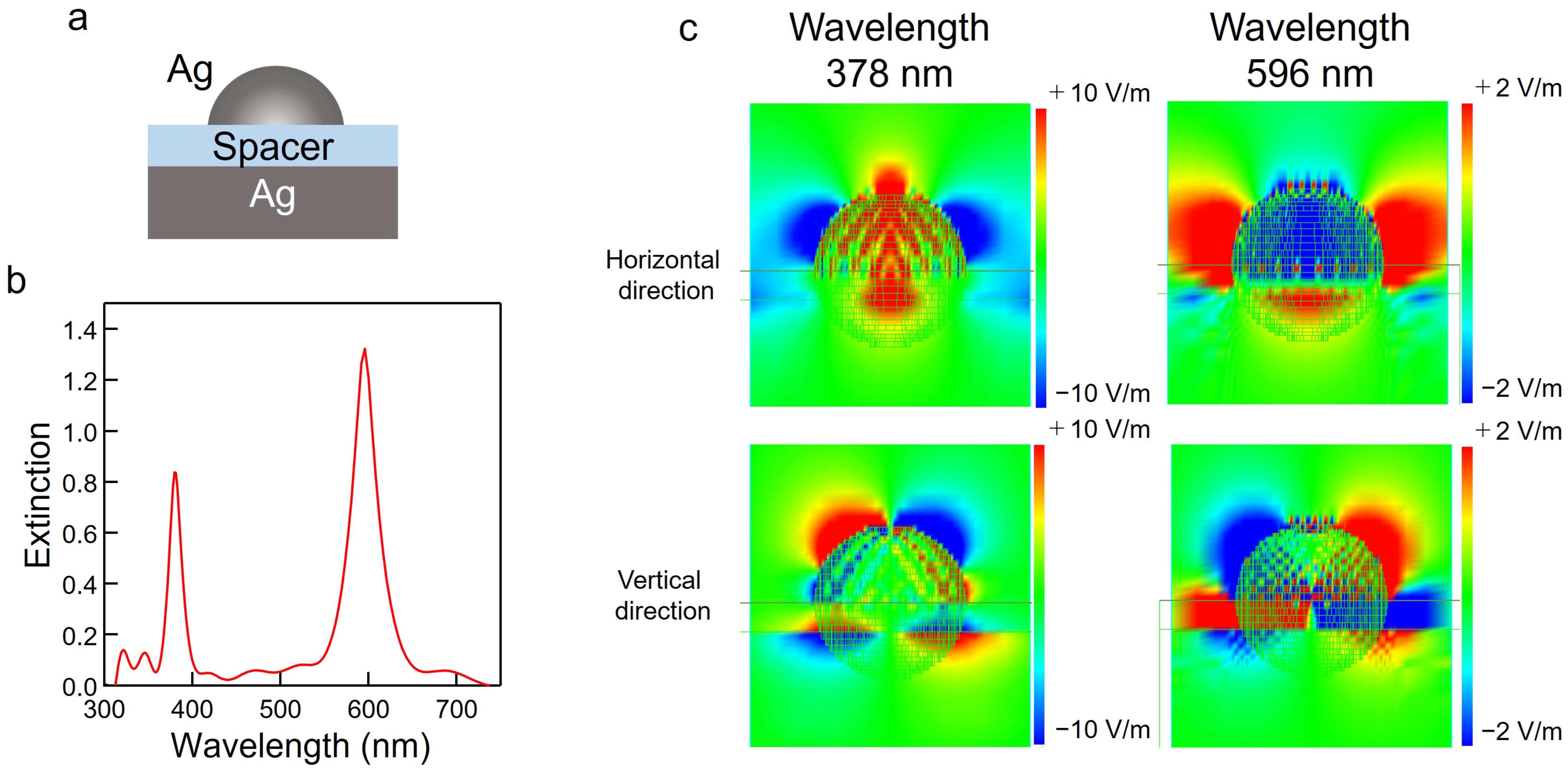
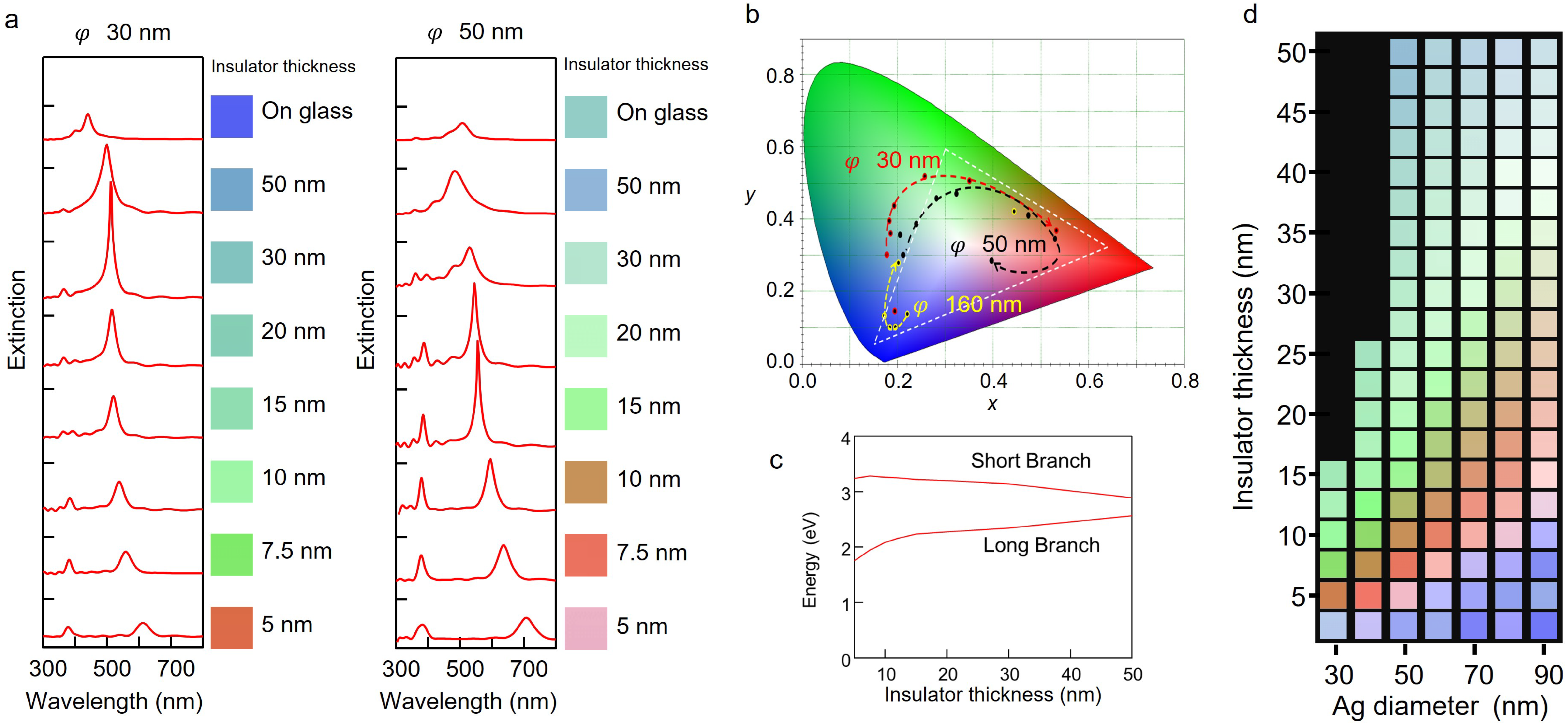
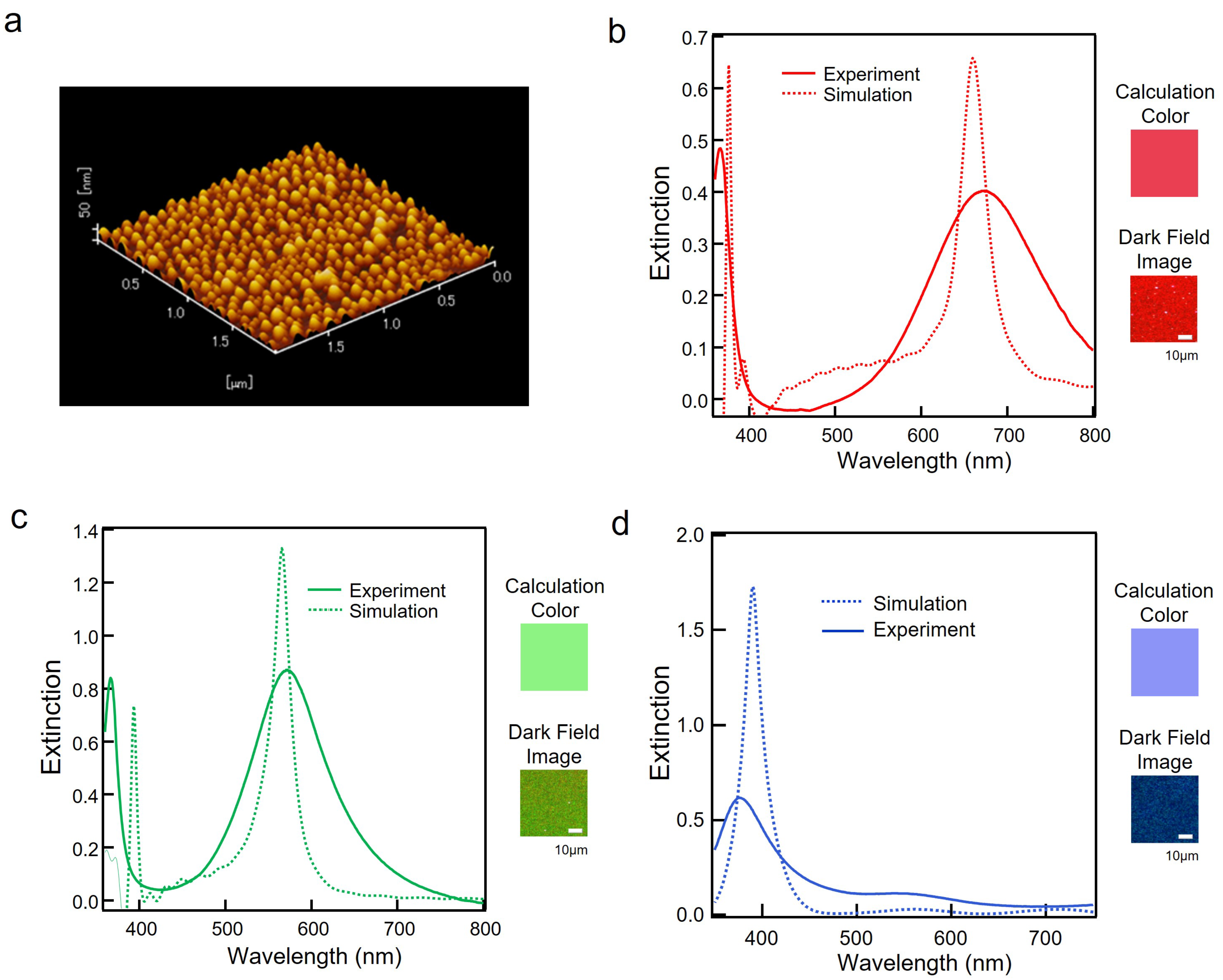
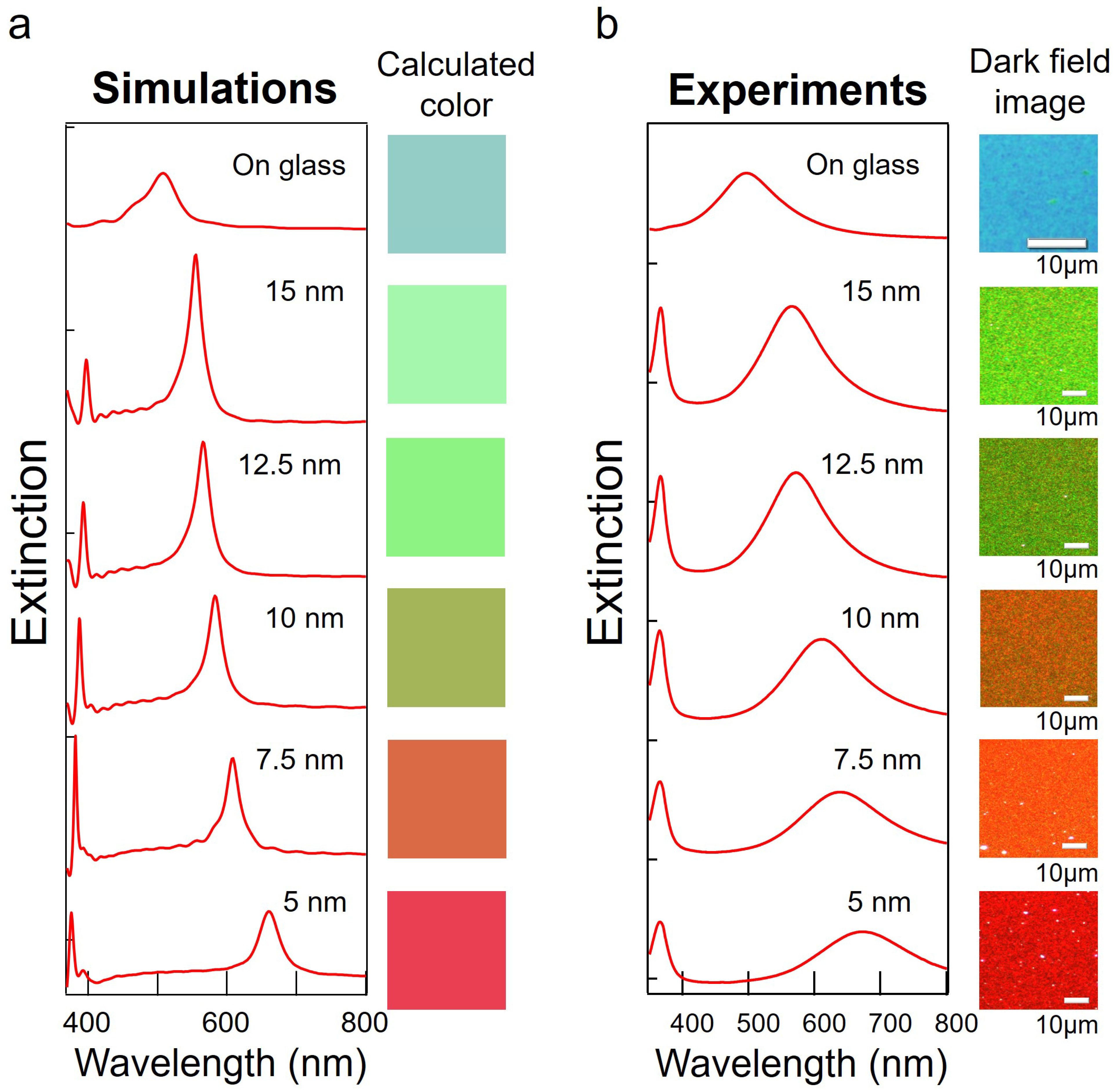
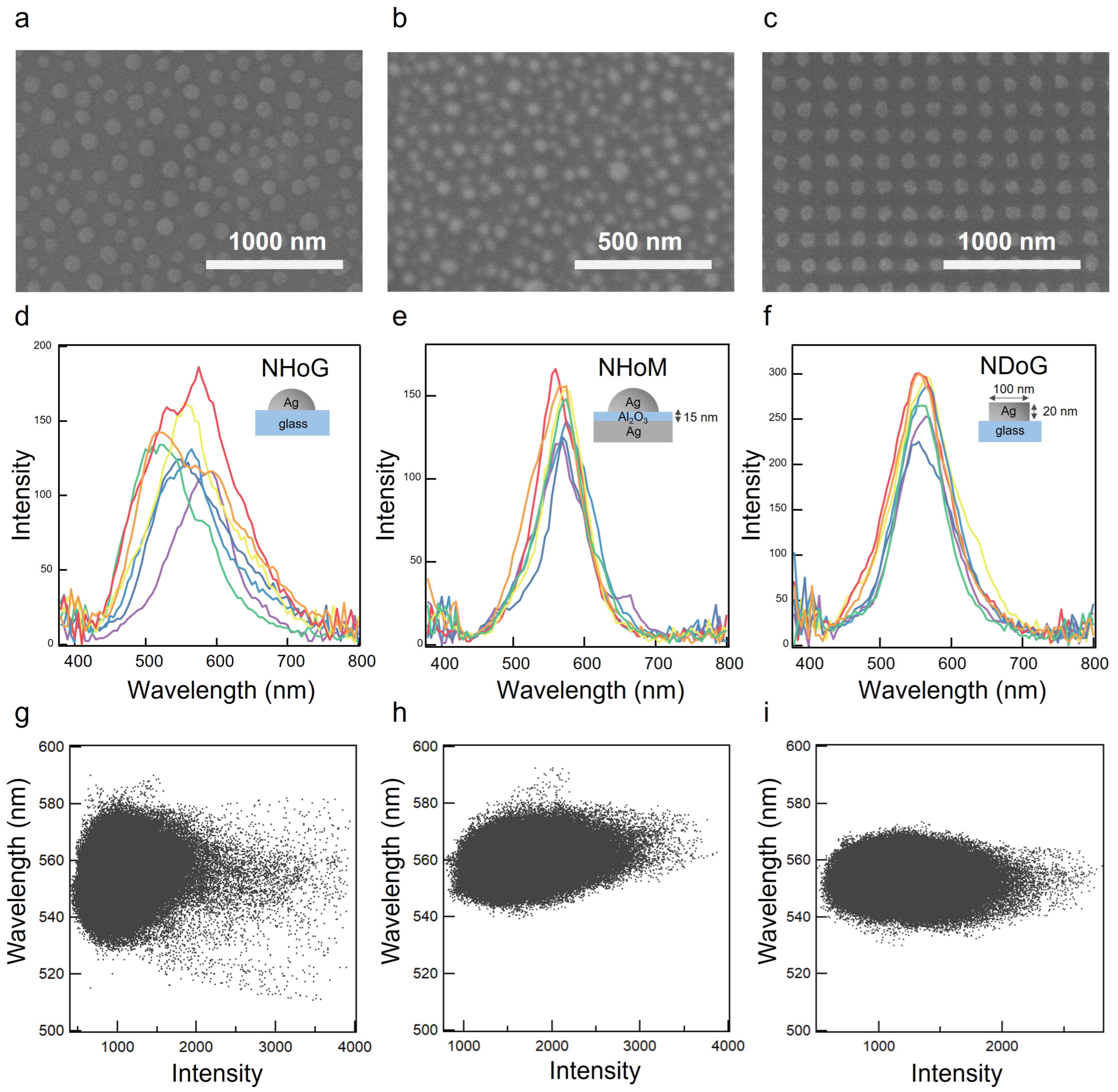
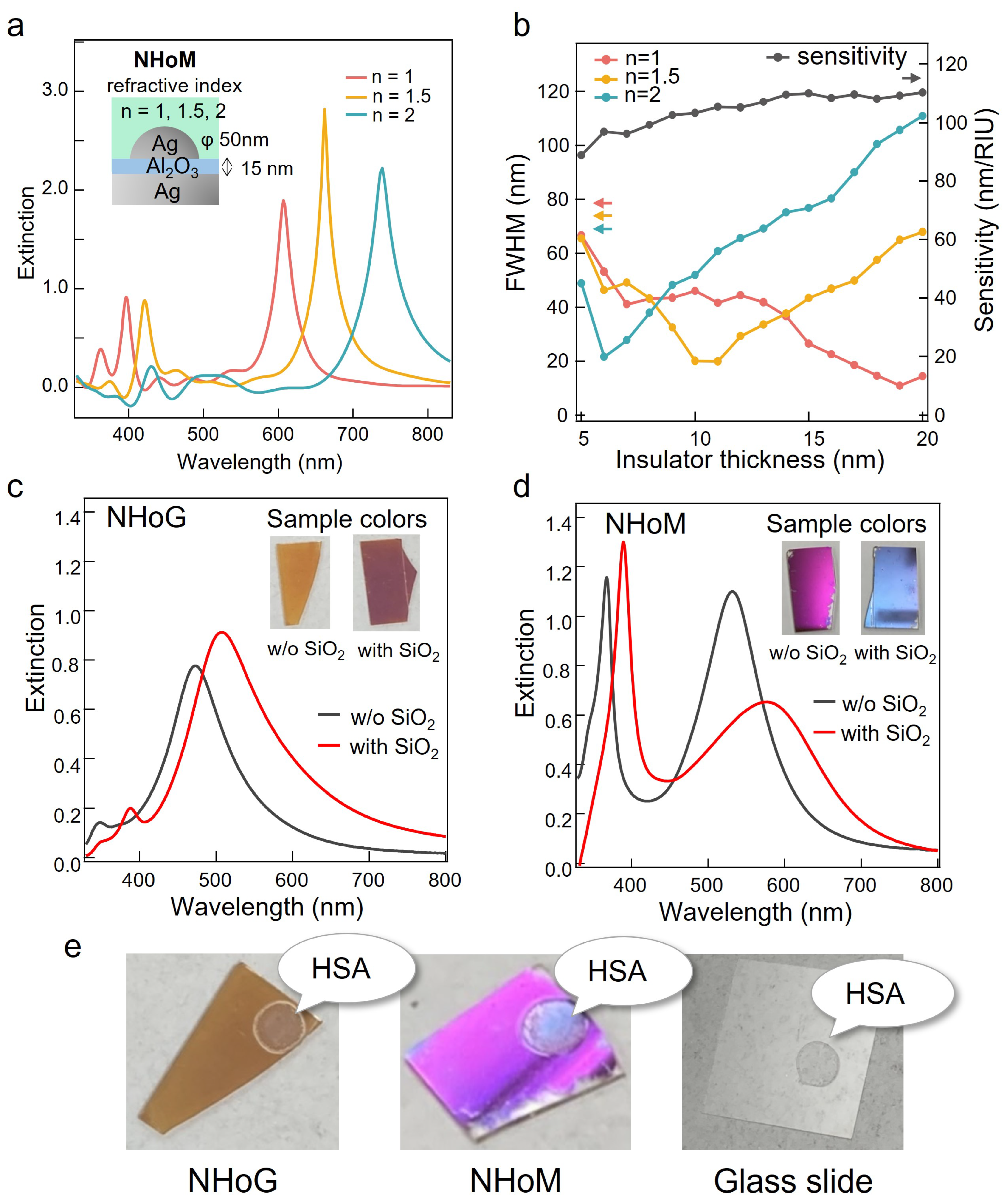
Disclaimer/Publisher’s Note: The statements, opinions and data contained in all publications are solely those of the individual author(s) and contributor(s) and not of MDPI and/or the editor(s). MDPI and/or the editor(s) disclaim responsibility for any injury to people or property resulting from any ideas, methods, instructions or products referred to in the content. |
© 2023 by the authors. Licensee MDPI, Basel, Switzerland. This article is an open access article distributed under the terms and conditions of the Creative Commons Attribution (CC BY) license (https://creativecommons.org/licenses/by/4.0/).
Share and Cite
Maeda, S.; Osaka, N.; Niguma, R.; Matsuyama, T.; Wada, K.; Okamoto, K. Plasmonic Metamaterial Ag Nanostructures on a Mirror for Colorimetric Sensing. Nanomaterials 2023, 13, 1650. https://doi.org/10.3390/nano13101650
Maeda S, Osaka N, Niguma R, Matsuyama T, Wada K, Okamoto K. Plasmonic Metamaterial Ag Nanostructures on a Mirror for Colorimetric Sensing. Nanomaterials. 2023; 13(10):1650. https://doi.org/10.3390/nano13101650
Chicago/Turabian StyleMaeda, Sayako, Noboru Osaka, Rei Niguma, Tetsuya Matsuyama, Kenji Wada, and Koichi Okamoto. 2023. "Plasmonic Metamaterial Ag Nanostructures on a Mirror for Colorimetric Sensing" Nanomaterials 13, no. 10: 1650. https://doi.org/10.3390/nano13101650
APA StyleMaeda, S., Osaka, N., Niguma, R., Matsuyama, T., Wada, K., & Okamoto, K. (2023). Plasmonic Metamaterial Ag Nanostructures on a Mirror for Colorimetric Sensing. Nanomaterials, 13(10), 1650. https://doi.org/10.3390/nano13101650




